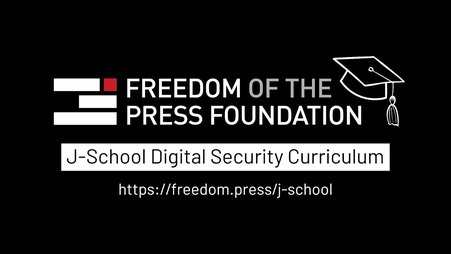Hi there!
It’s Evan, the newest senior digital security trainer at Freedom of the Press Foundation (FPF), filling in for Dr. Martin Shelton with our regular update on the U.S. Journalism School Digital Security Curriculum.
J-school security curriculum update
- Fresh off the heels of releasing our newest module tailored to students living and working near the U.S. southern border, we recently completed a review and refresh of the rest of our existing J-school curriculum.
- We’ve made several updates as part of this refresh. These include the addition of new phishing slides to illustrate common techniques in malware deployment, updated graphics in our Chat safety and Internet and telecommunications security modules to aid in the explanation of core concepts like encryption, metadata, and virtual private networks, as well as enhanced speaker’s notes to provide instructors with additional guidance and clarity. Take a look for yourself!
Highlights from digital security in the news
- In July, the U.S. federal court system’s electronic filing system was breached, disrupting operations and forcing courts in multiple states to revert to paper filings. The attack exposed sealed records and potentially compromised the identities of witnesses and informants. This system, also successfully breached in 2020, was left exposed thanks to vulnerabilities that “remained unaddressed after being discovered five years ago in response to that first incident”. Investigators suspect Russian government-affiliated hackers are at least partly responsible for the breach, and there is also concern about organized crime syndicates’ involvement as well given the nature of the data. Read more.
Suggested modules: File safety, Legal requests in the U.S. - The Tea app, which was launched in 2023 to “give women the tools they need to date safely” and had become one of the most downloaded apps in the App Store, was recently the subject of a massive data breach. An initial breach announced in July led to the exposure of tens of thousands of user photos and IDs which were posted on 4chan and subsequently distributed across the internet. An additional database containing the messages of over 1 million Tea app users was also discovered. These messages included what users believed to be private conversations discussing topics like abortions and cheating partners. How did this happen? Despite marketing itself as a safe space for women, the application apparently failed to implement even the simplest of security measures to protect its systems. Read more.
Suggested modules: Targeted harassment and doxxing, Internet and telecommunication security, Chat safety - A vulnerability in Microsoft’s on-premises SharePoint servers was exploited by Chinese government-affiliated hackers, impacting hundreds of organizations, including nonprofits and some U.S. government agencies, that host their own instances of SharePoint. After a vulnerability in SharePoint’s server software was identified and privately disclosed to Microsoft at a hacker competition in May, the company followed the typical process of updating the software to address the security gap and issued a public update to customers to apply the patch to their own servers. Unfortunately, this update did not fully fix the issue and, it appears, called attackers’ attention to the vulnerability, which was subsequently exploited. Microsoft has since issued an update that fully patches the vulnerability, but not until after hundreds of servers were compromised. Read more.
Suggested module: Malware
What we’re reading:
- We’re catching up on this year’s Data Breach Investigations Report, an annual publication put together by Verizon that highlights the global landscape of data breach tactics, techniques, and trends. One clear takeaway from the 2025 report is the 34% increase in the exploitation of vulnerabilities as an initial method for breaches. In plain terms, this means that bad actors are increasingly taking advantage of security gaps in systems and software (see some of the news stories above for examples!) to gain access to sensitive information. This method is now nearly tied with the theft and misuse of credentials (e.g., passwords) as the most common breach method. This shift highlights the importance of promptly updating systems as soon as security fixes are released and also underscores the importance of carefully considering the security practices and reputation of third-party services and vendors, whose systems and tools are now involved in a full 30% of breaches, according to the report.
As always, let our team know how you’re using the curriculum, what’s useful, and how it can be improved! Feel free to respond to this email or [email protected].
Thanks so much,
Evan
--
Evan Summers
Senior Digital Security Trainer
Freedom of the Press Foundation




